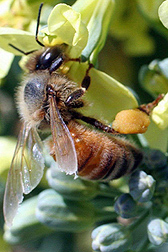This page has been archived and is being provided for reference purposes only. The page is no longer being updated, and therefore, links on the page may be invalid.
|
|
|
|
USDA/AIA Survey Reports 2010/2011 Winter Honey Bee Losses
By Kim KaplanMay 23, 2011
WASHINGTON — Total losses from managed honey bee colonies nationwide were 30 percent from all causes for the 2010/2011 winter, according to the annual survey conducted by the U.S. Department of Agriculture (USDA) and the Apiary Inspectors of America (AIA).
This is roughly similar to total losses reported in similar surveys done in the four previous years: 34 percent for the 2009/2010 winter, 29 percent for 2008/2009; 36 percent for 2007/2008, and 32 percent for 2006/2007.
"The lack of increase in losses is marginally encouraging in the sense that the problem does not appear to be getting worse for honey bees and beekeepers," said Jeff Pettis, an entomologist with USDA's Agricultural Research Service (ARS) who helped conduct the study. "But continued losses of this size put tremendous pressure on the economic sustainability of commercial beekeeping." Pettis is the leader of the Bee Research Laboratory operated in Beltsville, Md., by ARS, the chief scientific research agency of USDA.
The survey, which covered the period from October 2010 to April 2011, was led by Pettis and by AIA past presidents Dennis vanEngelsdorp and Jerry Hayes.
Beekeepers reported that, on average, they felt losses of 13 percent would be economically acceptable. Sixty-one percent of responding beekeepers reported having losses greater than this.
Average colony loss for an individual beekeeper's operation was 38.4 percent. This compares to an average loss of 42.2 percent for individual beekeepers' operations in 2009/2010.
Average loss by operation represents the percentage of loss in each operation added together and divided by the number of beekeeping operations that responded to the survey. This number is affected more by small beekeeping operations, which may only have 10 or fewer colonies, so a loss of just five colonies in a 10-colony operation would represent a 50 percent loss. Total losses were calculated as all colonies reported lost in the survey divided by the total number of bee colonies reported in the survey. This number is affected more by larger operations, which might have 10,000 or more colonies, so a loss of five colonies in a 10,000-colony operation would equal only a 0.05 percent loss.
Among surveyed beekeepers who lost any colonies, 31 percent reported losing at least some of their colonies without finding dead bee bodies—one of the symptoms that defines Colony Collapse Disorder (CCD). As this was an interview-based survey, it was not possible to differentiate between verifiable cases of CCD and colonies lost as the result of other causes that share the "absence of dead bees" as a symptom. The cause of CCD is still unknown.
The beekeepers who reported colony losses with no dead bee bodies present also reported higher average colony losses (61 percent), compared to beekeepers who lost colonies but did not report the absence of dead bees (34 percent in losses).
A total of 5,572 beekeepers, who manage more than 15 percent of the country's estimated 2.68 million colonies, responded to the survey.
A complete analysis of the survey data will be published later this year. The abstract can be found at http://www.extension.org/pages/58013/honey-bee-winter-loss-survey.
More information about CCD can be found at www.ars.usda.gov/ccd.

